AbstractImaging of the lymphatic system has always encountered difficulties, such as high costs, timeconsuming procedures, and low-resolution images. Each method of imaging provides its own challenges. The use of high-resolution ultrasonography (HR-US) and microvascular flow imaging (MVFI) may prove to be the most effective method for visualizing the superficial lymphatic vessels. This study investigated the utilization of HR-US and MVFI in imaging inguinal lymph nodes and vessels, as well as the innovative use of an intranodal saline injection that acted as a contrast agent. This technical note aims to demonstrate that HR-US and MVFI, in combination with an intranodal saline injection, are applicable to the dynamic imaging of superficial inguinal lymph nodes and vessels.
Imaging the fine-meshed network of the lymphatic system has remained a major challenge, as it is difficult to access with various contrast agents, unlike the usual contrast examinations performed in the radiology department. An accurate and sensitive imaging technique is required to visualize the lymph vessels and flow to identify abnormalities such as lymphedema and lymphangiectasia. This is necessary to obtain a correct diagnosis and create a patient-specific therapy plan. Over the years, several imaging techniques have emerged to enable the visualization of the peripheral lymph vessels and their flow, each with its own advantages and limitations.
Lymphangiography of the extremities can be performed by injecting ethiodized oil as a contrast agent, either inter-digitally or directly into a lymph vessel in the foot. In lymphoscintigraphy, a radioactive agent (99mtechnetium nano-colloid) is injected inter-digitally and its path is then followed through the extremities, with the resulting images being low-resolution. Alternatively, the superficial (peripheral) lymphatic vessels can be visualized using indocyanine green; however, this is a time-consuming technique that also results in low-resolution images. Other radiological modalities, such as magnetic resonance imaging, computed tomography, and fluoroscopy [1,2], can be used for lymphangiography after a minimally invasive inguinal intranodal contrast injection, enabling the visualization of the central, para-aortoiliac lymphatic vessels. This can be of diagnostic relevance in cases of chylothorax or chylous ascites [3,4]. These methods are all laborious and time-consuming.
In search of a more easily applicable, high-resolution, and dynamic modality, state-of-the-art ultrasound techniques could be applied to image superficial lymphatic vessels. These techniques have also been able to provide slow-flow information. The use of contrast-enhanced ultrasonography (CEUS) with an intranodal injection of microbubbles (Sonovue, Bracco, Milan, Italy), has proven valuable for imaging both central [5] and peripheral lymphatic vessels [6,7]. Dynamic imaging gives insights into the flow direction, which can be normal antegrade, abnormally retrograde, or both. Furthermore, several ultrasound manufacturers have recently developed microvascular flow imaging (MVFI) techniques (e.g., Superb Microvascular Imaging [SMI] by Canon Medical Systems, Tokyo, Japan; Micro Flow Imaging by Philips Medical Systems, Best, The Netherlands; Slow Flow by Siemens Healthineers, Erlangen, Germany; Microvascular Imaging by GE Healthcare, Chalfont St Giles, UK; and MV-flow by Samsung Healthcare, Seoul, Korea). These techniques use different algorithms from the conventional Doppler techniques, in order to visualize slow-flow velocity and small-diameter (blood) vessel flow. MVFI could play a role in the niche where CEUS is used [8]. Some studies have even suggested that MVFI is a valuable alternative to CEUS [9,10].
Due to the improved resolution of ultrasound machines and their potential to image low-flow velocities, the combination of high-resolution ultrasonography (HR-US) and MVFI could be applied to the imaging of vessels that transport fluids at very slow rates. The authors have started to explore the potential of using HR-US and MVFI in imaging the superficial lymphatic vessels. This technical note presents the first results.
Approval from the local ethics committee (Commissie Mensgebonden Onderzoek–CMO 2020-6651) was obtained for this single-center study. All patients provided written informed consent.
The participants (n=84) who received lymphatic ultrasound examinations were patients with suspected central or peripheral lymphatic disorders (for example, lymphedema, chylothorax/chyluria, traumatic or iatrogenic lymphatic leakages, and/or congenital lymphatic anomalies), who underwent diagnostic contrast-enhanced MR-lymphangiography (DCMRL). The patients were between 0 and 86 years old. There were no exclusion criteria for ultrasonography prior to DCMRL.
All examinations were performed by a single radiologist with more than 10 years of experience in ultrasonography, between December 2018 and December 2022, with a Canon i800 series using an i24LX8 linear matrix transducer (Canon Medical Systems), equipped with SMI. Both inguinal areas were examined prior to DCMRL, with the patient in the supine position, in order to detect suitable lymph nodes for intranodal injection. HR-US was used while placing the intranodal needle [1]. The needle tip was placed at the corticomedullar border (Fig. 1).
After the placement of one intranodal 25G needle (Pencan, B. Braun Medical B.V., Oss, The Netherlands) in the inguinal lymph nodes on each side, HR-US was used to visualize the lymphatic flow from these lymph nodes. The monochrome version of MVFI in Canon’s SMI (mSMI)-box was activated with a maximum velocity of 1.0 cm/s in order to visualize the lymphatic flow. A small amount (approximately 2 mL) of saline solution (0.9% NaCl) was injected at a rate of 0.5-1.0 mL/min and visualized using HR-US with mSMI.
The saline solution was used as a contrast agent to visualize the antegrade, efferent flow (i.e., in the cranial direction away from the inguinal lymph node). To qualitatively assess the flow, the saline solution must be injected and cine loops must be created. Ultrasound images and the correlation between HR-US and the results of the DCMRL can be reviewed. In cases of dilated lymph vessels, dilation is visible on grayscale images without the introduction of a saline solution. Vessels are classified as dilated if no flow is detected and the diameter is larger than the usual 1-2 mm in the lower extremities [11]. Flow images should be revised by looking at the direction of the flow and the progression of the saline solution into the surrounding tissues. Flow is classified as antegrade (efferent) when it travels in the cranial direction, with a slow velocity (in accordance with the injection rate) or as retrograde when it travels in the caudal (afferent) direction. The needle position can be considered inadequate if the injected fluid accumulates around the lymph node and seeps into the surrounding dermal tissues (dermal backflow) or if the efflux demonstrates fast (venous) flow, which could also be a sign of lympho-venous shunting.
Exemplary examinations demonstrating pathologic findings are included in the Results section.
Lymph enters the lymph nodes via the convex side, on which the afferent lymphatic vessels are drained. The lymphatic vessels contain valves that allow the lymph to flow solely in the antegrade (cranial) direction. When assessing the lymph nodes and surrounding tissue using mSMI at 1.3 cm/s, no lymphatic flow was measured. The velocity was selected in order to visualize the applied flow, but not limit the effects of artifacts. When moderate pressure was applied with a syringe, antegrade, gently pulsating lymphatic flow was visualized in the efferent lymphatic vessels (Fig. 2, Video clip 1). After releasing the syringe pressure, lymphatic flow gradually stopped and was no longer visible after a few seconds (Video clip 2). The visibility was limited to only the locoregional area of the intranodal-approached lymph node.
In cases of lymphedema in the lower extremities, possibly caused by congenital thoracic duct aplasia, iatrogenic and traumatic injuries, or chronic high pressures in the lymphatic system (secondary to high venous pressure), the peripheral lymphatic vessels can become dilated or obstructed. This causes the saline solution to flow in different directions (antegrade and retrograde). The following paragraphs describe these pathologies.
In some cases, dilatation can lead to backflow into the dermal layers, causing lymphedema. When assessing this phenomenon, flow out of the lymph node into the efferent lymphatic vessel is seen and its tortuous trajectory is visible (Fig. 3). After injecting additional saline solution, the backflow becomes evident when the saline seeping into the ventral dermal layers.
Dilated peripheral lymphatic vessels can be visualized using B-mode ultrasonography (Fig. 4). When applying only minimal pressure with the ultrasound probe, the vessels are discernable as tubular structures without any conventional Doppler flow. Dilation can cause the lymphatic valves to become insufficient, leading to lymphatic stasis.
In case of leaking lymphatic valves, the injection of a saline solution can lead to retrograde flow in the peripheral lymphatic vessels (Fig. 5). After injecting saline solution, flow is seen in both antegrade and retrograde directions (Video clip 3). Flow rates are difficult to quantify due to the too-low frame rate in this application in the triplex mode, in which grayscale, SMI, and pulsed-wave Doppler are visible. A qualitative assessment shows that the saline solution flows in a retrograde direction.
In case of incorrect needle placement or luxation of the needle, extravasation of the fluid can occur (Fig. 6, Video clip 4). As the contrast agent used is 0.9% NaCl saline solution, this is harmless to the patient, although it can be painful. If no lymph node is located, the procedure should be repeated in order to find the correct needle placement to visualize the lymphatic vessels.
The main finding of this study is that HR-US seems to be a valuable method for visualizing the superficial lymphatic vessels and flow. It was possible to distinguish normal antegrade from abnormal and retrograde flow, as well as normal from ectatic lymph vessels.
Until recently, conventional B-mode ultrasound techniques were not suitable for imaging small lymphatic vessels or measuring very slow lymphatic flow. However, recent technical advances have made ultrasonography a potential lymphatic imaging modality due to major improvements in temporal and spatial resolution, leading to the development of HR-US. Previously, HR-US using transmitted frequencies above 15 MHz, was only feasible using specialized, pre-clinical imaging systems [12]. Recent developments in transducer technology have produced a clinical transducer operating up to 29 MHz, resulting in HR-US images with an extremely high resolution of 70 μm [13]. Conventional color Doppler flow imaging (CDFI) uses a filter to remove motion, clutter, and wall artifacts, but low-flow information is removed as well. The algorithm of MVFI analyzes clutter not only in the temporal domain, but also in the spatial domain. This results in improved removal of the wall and motion artifacts, while preserving low-flow information. Consequently, MVFI provides images with very slow flow, down to 0.3 cm/s (0.3 cm/s is the lowest velocity that can be utilized on the scale of SMI. No documentation regarding minimal flow velocity is available at this moment).
Imaging of the lymphatic vessels has always been a challenge [4], and each imaging method has its disadvantages, such as being laborious or having low temporal or spatial resolution. In search for a more easily applicable imaging modality, HR-US with MVFI has potential as a relatively inexpensive, dynamic, and fairly quick technique to image superficial lymphatic vessels. MVFI has the advantage of high frame rates, high sensitivity, and—due to its algorithm—a reduced presence of artifacts, potentially making it a feasible technique for detecting slow superficial lymphatic flow [14,15]. The mSMI mode improves flow sensitivity by subtracting the background information from grayscale images and focusing only on the flow in the vessels [8]. SMI has been studied for use in the detection of sentinel lymph nodes and micro-vascularization in superficial tissues and organs, providing additional information in ultrasound examinations [9,14]. The advantage of SMI over CDFI is that with SMI, most of the hindering motion artifacts are removed, thus revealing the true flow [15,16]. The patency of thoracic duct outflow has been studied using CEUS [17]. Previous studies have investigated the applicability of MVFI in characterizing thyroid lesions [16,18,19] and renal masses [10] in comparison to CEUS. Some studies have compared the efficacy of both CEUS and MVFI for various applications [10], suggesting that MVFI is a valuable alternative for CEUS [9,10] or may even function as a replacement for CEUS in certain cases [8,18]. With the intranodal technique, imaging is limited to only the locoregional area of interest, due to the fact that the lymphatic flow is visualized using the pressure applied using the syringe. Malposition of the intranodal needle can lead to venous outflow after the injection of saline. This may be seen as diluted and relatively fast outflow. The venous vessels are larger than the lymph vessels and will possibly show a lower intensity in the mSMI-box due to the dilution of the flow within the slow bloodstream. Lympho-venous shunting is expected to show similar venous flow, but this possibility requires further investigation.
Smooth muscle cells in the lymphatic wall, adjacent muscle contractions, arterial flow, and respiratory movements of the chest cavity all contribute to antegrade lymphatic flow [11]. This study found that in cases of high systemic (iatrogenic or traumatic) lymphatic pressure, lymphedema, or abnormal anatomy, MVFI can be used to determine retrograde flow or local flow into the dermal layers. In line with previous studies that assessed other body parts, HR-US and MVFI were found to be useful additional tools for imaging superficial lymphatic vessels. Further investigations could determine whether HR-US and MVFI are feasible in diagnostic examinations of superficial lymphatic abnormalities.
NotesAuthor Contributions Conceptualization: Vullings JJJ, Klein WM. Data acquisition: Vullings JJJ, van Schaik C, Klein WM. Data analysis or interpretation: Vullings JJJ, Fütterer JJ, de Korte CL, Klein WM. Drafting of the manuscript: Vullings JJJ. Critical revision of the manuscript: Vullings JJJ, van Schaik C, Fütterer JJ, de Korte CL, Klein WM. Approval of the final version of the manuscript: all authors. References2. Itkin M, Nadolski GJ. Modern techniques of lymphangiography and interventions: current status and future development. Cardiovasc Intervent Radiol 2018;41:366–376.
3. Patel S, Hur S, Khaddash T, Simpson S, Itkin M. Intranodal CT lymphangiography with water-soluble iodinated contrast medium for imaging of the central lymphatic system. Radiology 2022;302:228–233.
4. van Schaik CJ, Boer LL, Draaisma JM, van der Vleuten CJ, Janssen JJ, Futterer JJ, et al. The lymphatic system throughout history: from hieroglyphic translations to state of the art radiological techniques. Clin Anat 2022;35:701–710.
5. Mejia EJ, Otero HJ, Smith CL, Shipman M, Liu M, Pinto E, et al. Use of contrast-enhanced ultrasound to determine thoracic duct patency. J Vasc Interv Radiol 2020;31:1670–1674.
6. Lahtinen O, Vanninen R, Rautiainen S. Contrast-enhanced ultrasound: a new tool for imaging the superficial lymphatic vessels of the upper limb. Eur Radiol Exp 2022;6:18.
7. Jang S, Lee CU, Hesley GK, Knudsen JM, Brinkman NJ, Tran NV. Lymphatic mapping using US microbubbles before lymphaticovenous anastomosis surgery for lymphedema. Radiology 2022;304:218–224.
8. Aziz MU, Eisenbrey JR, Deganello A, Zahid M, Sharbidre K, Sidhu P, et al. Microvascular flow imaging: a state-of-the-art review of clinical use and promise. Radiology 2022;305:250–264.
9. Wakisaka N, Endo K, Kitazawa T, Shimode Y, Kato K, Moriyama-Kita M, et al. Detection of sentinel lymph node using contrast-enhanced agent, Sonazoid, and evaluation of its metastasis with superb microvascular imaging in oral and oropharyngeal cancers: a preliminary clinical study. Acta Otolaryngol 2019;139:94–99.
10. Leong JY, Wessner CE, Kramer MR, Forsberg F, Halpern EJ, Lyshchik A, et al. Superb microvascular imaging improves detection of vascularity in indeterminate renal masses. J Ultrasound Med 2020;39:1947–1955.
11. Margaris KN, Black RA. Modelling the lymphatic system: challenges and opportunities. J R Soc Interface 2012;9:601–612.
12. Daeichin V, van Rooij T, Skachkov I, Ergin B, Specht PA, Lima A, et al. Microbubble composition and preparation for high-frequency contrast-enhanced ultrasound imaging: in vitro and in vivo evaluation. IEEE Trans Ultrason Ferroelectr Freq Control 2017;64:555–567.
13. Saita A, Lughezzani G, Buffi NM, Hurle R, Nava L, Colombo P, et al. Assessing the feasibility and accuracy of high-resolution microultrasound imaging for bladder cancer detection and staging. Eur Urol 2020;77:727–732.
14. Hata J. Seeing the unseen. Clinical advances and future directions of SMI. Otawara: Toshiba Medical Systems Corporation, 2015.
15. Ma Y, Li G, Li J, Ren WD. The diagnostic value of superb microvascular imaging (SMI) in detecting blood flow signals of breast lesions: a preliminary study comparing SMI to color Doppler flow imaging. Medicine (Baltimore) 2015;94:e1502.
16. Lu R, Meng Y, Zhang Y, Zhao W, Wang X, Jin M, et al. Superb microvascular imaging (SMI) compared with conventional ultrasound for evaluating thyroid nodules. BMC Med Imaging 2017;17:65.
17. Seeger M, Bewig B, Gunther R, Schafmayer C, Vollnberg B, Rubin D, et al. Terminal part of thoracic duct: high-resolution US imaging. Radiology 2009;252:897–904.
B-mode image showing normal inguinal lymph node (*) with 25G needle placed (arrows) at the corticomedullar border. 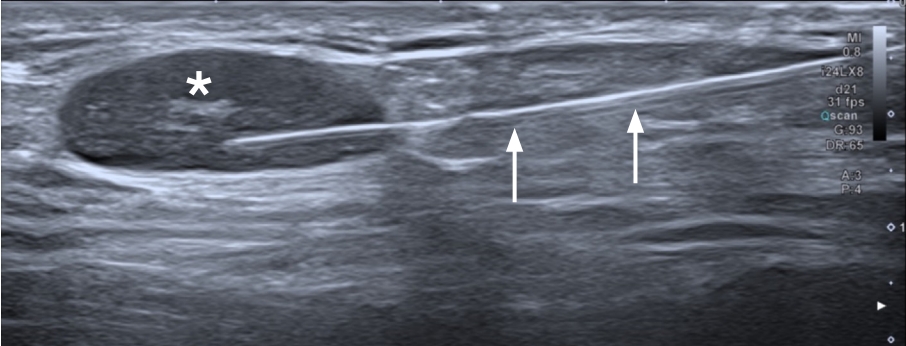 Fig. 1.Superb Microvascular Imaging in an inguinal lymph node after saline injection.The lymphatic cortex is depicted within the dashed circle with 25G needle (arrow) placed at the corticomedullar border. Antegrade lymph flow of the saline can be seen in the hilum and efferent lymph vessel (hyperechogenic depiction, annotated with arrowheads).
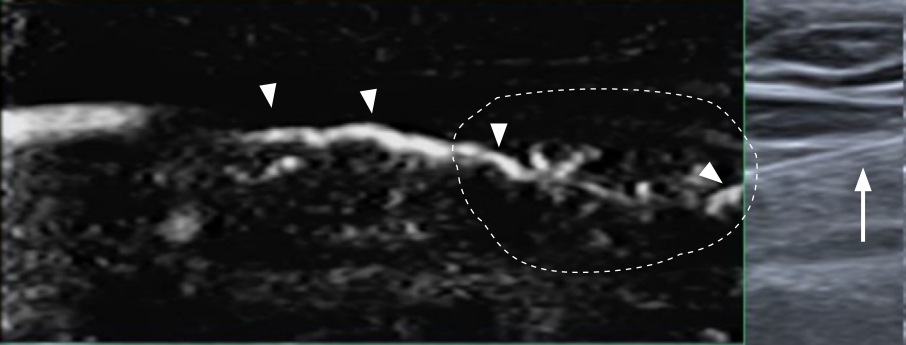 Fig. 2.Superb Microvascular Imaging images of saline solution, injected with needle (arrow), at the corticomedullar border of an inguinal lymph node.A. Efferent lymph flow can be seen (arrowheads). B. Approximately 3 seconds after injection, tortuous lymph vessels were visible, just as dermal backflow started to occur and saline ventral effusion visualized (arrowheads). The lymphatic cortex is depicted with the dashed circle.
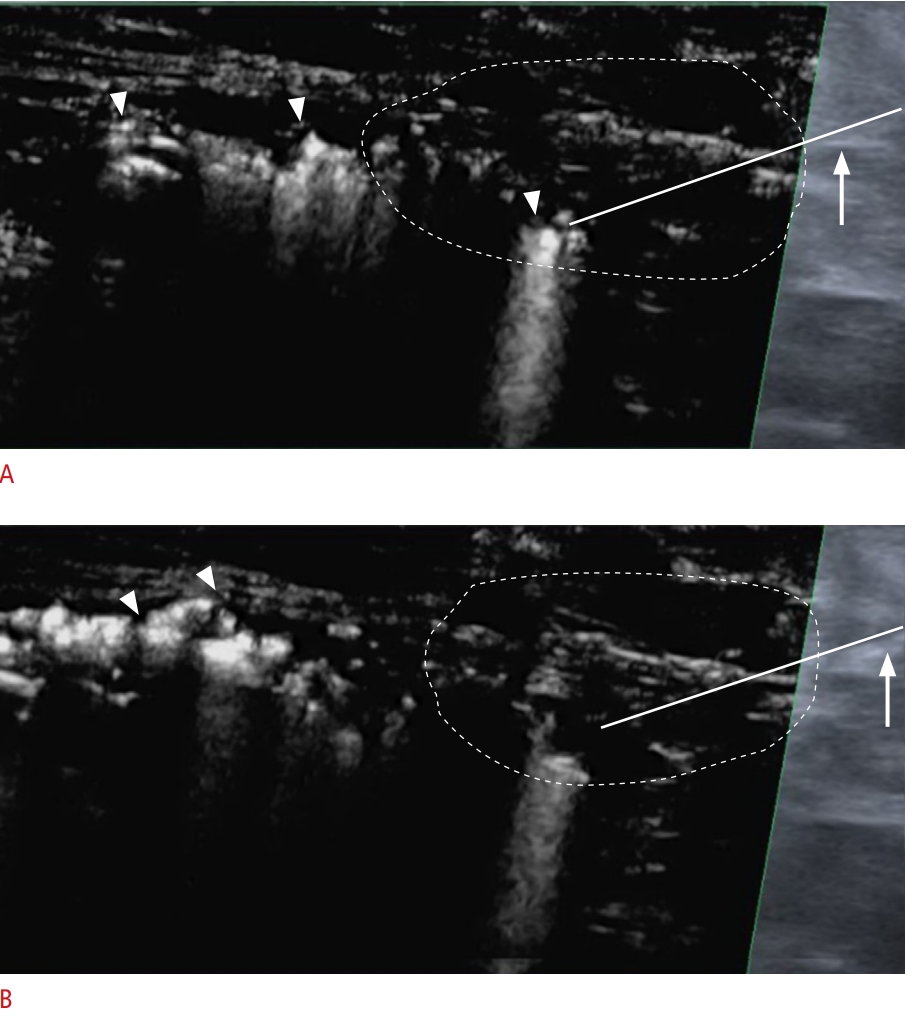 Fig. 3.B-Mode image showing an inguinal lymph node with an afferent dilated lymphatic vessel.Arrows show the afferent lymphatic vessel into an inguinal lymph node (dashed circle).
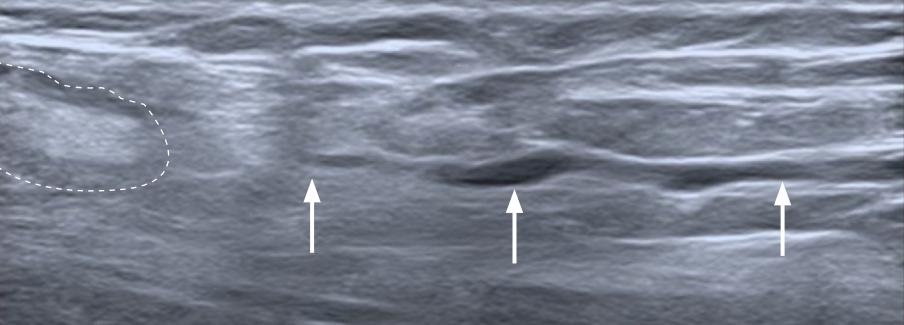 Fig. 4.Retrograde flow after saline injection.A. Injection of saline solution into inguinal lymph node can be seen. Arrowheads indicate the flow from the injected saline solution at T=2.0 s post injection. B. Efferent lymph flow can be seen at T=0.4 s post injection, as well as retrograde flow, indicated by the right-sided arrowheads. C. Retrograde flow can be seen further upstream at T=0.7 s post injection. All arrowheads at the left side of the needle tip indicate efferent flow, all right-sided arrowheads indicate retrograde flow.
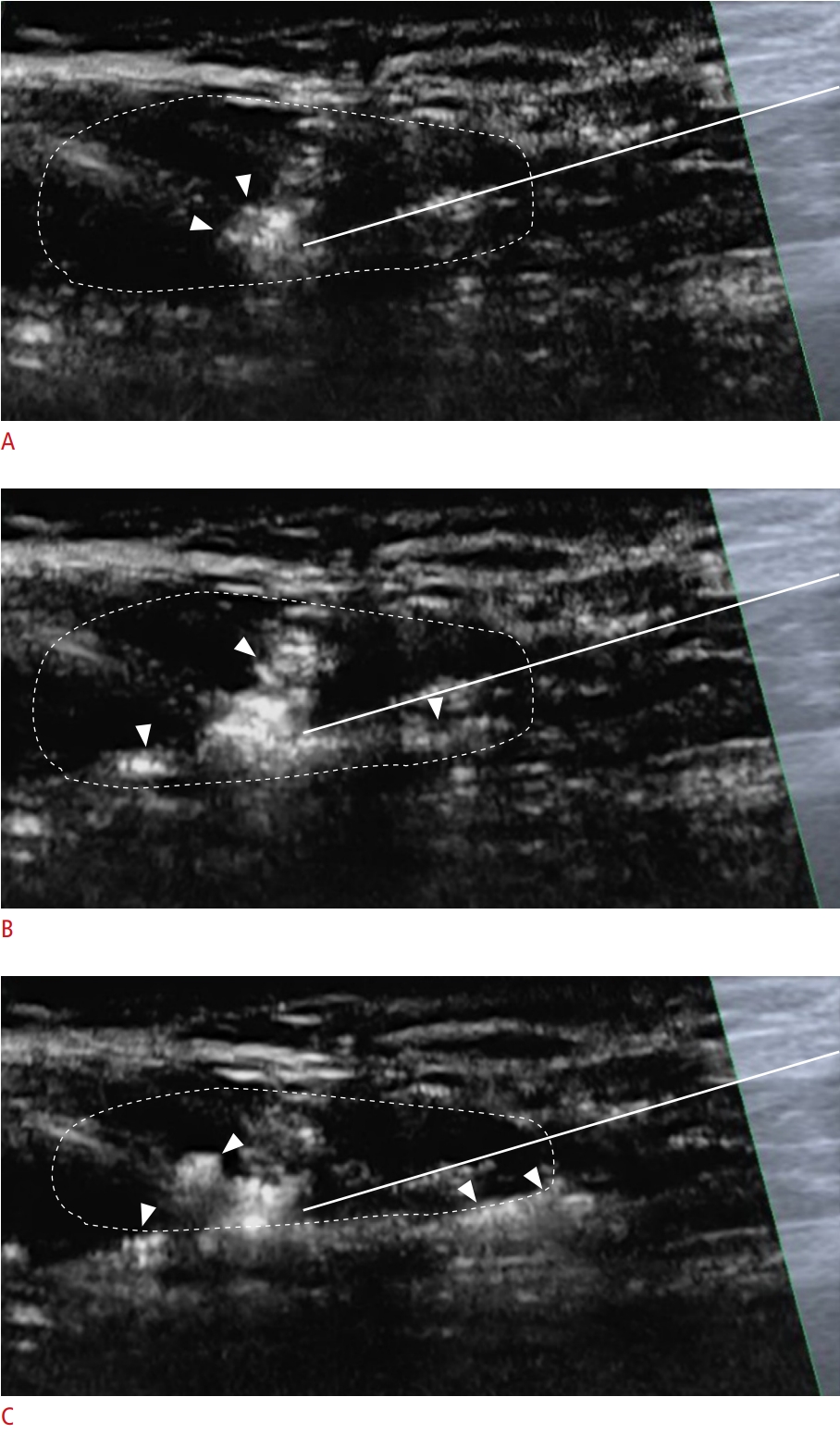 Fig. 5.Example of extravasation.A. Needle was placed in a supposed lymph node. The dashed lines show the muscular fasciae. B. At T=1 s post injection, the injected saline (arrowheads) is visible. C. At T=4 s post injection the results of the extravasation show, when the saline pushes the fasciae apart (arrowheads).
 Fig. 6. |
| |||||||||||||||||||||||||||||



 Print
Print facebook
facebook twitter
twitter Linkedin
Linkedin google+
google+
 Download Citation
Download Citation PDF Links
PDF Links PubReader
PubReader ePub Link
ePub Link Full text via DOI
Full text via DOI




